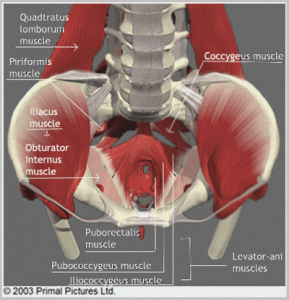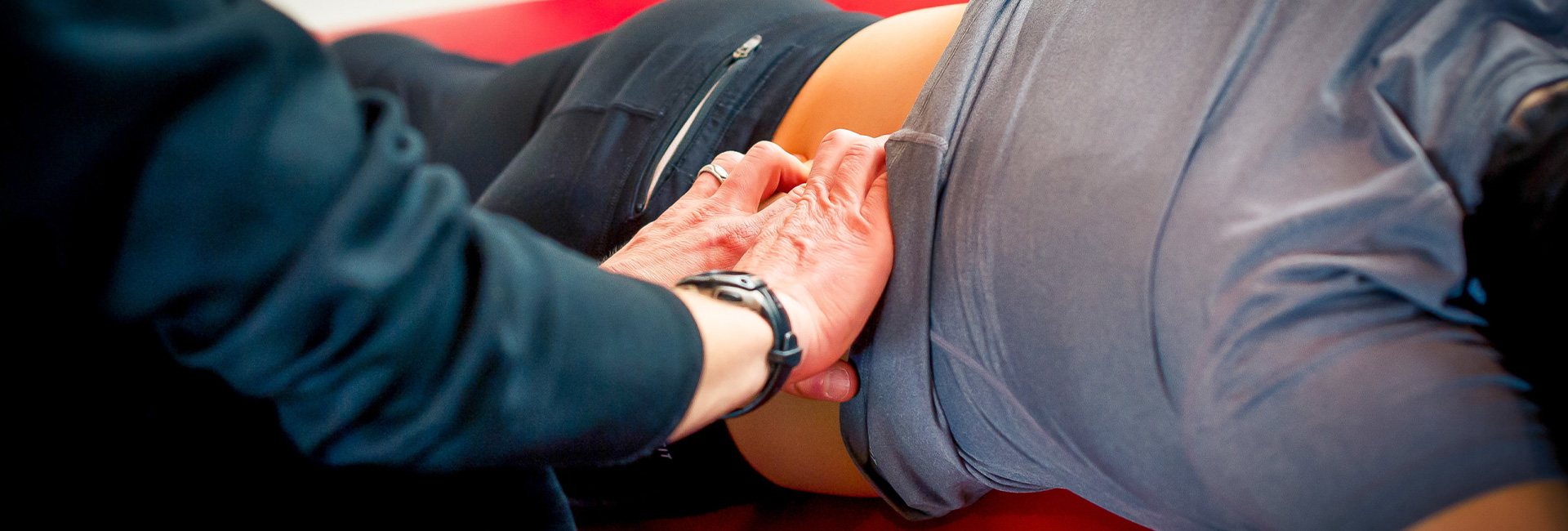Pelvic pain is any pain internally/externally over pelvis and genital areas. The pain can be attributed to several different causes such as pregnancies, surgery, infection, abuse and possibly no cause. Pain is usually attributed to tightness or hypertonic muscles of the pelvic floor.
How is pelvic pain diagnosed?
Your health care provider will interview you about your medical history and then conduct a physical exam, including a pelvic floor exam. While it can be intimidating, knowing what to expect during a pelvic floor examination can alleviate any anxiety you may have. Our pelvic health specialists will support you every step of the way.

What are some conditions that include pelvic pain?
- Levator ani syndrome or pelvic floor tension myalgia
Chronic or recurring rectal pain that lasts 20 minutes or longer with reproduction of pain/pressure/ache or tenderness of pelvic floor structures on rectal or vaginal exam usually poorly localized
- History: Previous pelvic surgery causing trauma to the muscles or blood or nerve supply, childbirth injury, lumbar disc surgery, sexual injury, pelvic inflammation/infection, habitual and postural patterns
- Cause: Overactivity of levator ani muscles from trigger of injury, disease or surgery, learned habitual guarding
- Treatment: Massage, myofascia and trigger point treatments, electrotherapy, SEMG biofeedback to downtrain the pelvic floor muscle tension
- Dyspareunia
Pain in the absence of organic disease localized to the vagina or lower pelvis with penetration or thrusting
- Treatment: Massage, trigger point release, ultrasound
- Vaginismus
Inability to penetrate vagina, spasm or active holding of introital muscles
- Cause: Protective response to another conistion or inflammation
- Treatment: Relaxation with biofeedback, hip stretching, soft tissue mobilization, trigger point techniques, vaginal stretching with dilators, patient education
- Generalized vulvodynia
Chronic, vulvar discomfort or pain characterized by burning, stinging, irritation or rawness of the female genitalia without infection
- Causes: Unsure, yeast infections, dermatitis, may also have bladder pain
- Treatment: Medication, surgery, psychiatric care, physical therapy, oxylate diet
- Vulvar vestibulitis
Pain to the vulvar vestibule on touch or vaginal entry with swelling to the vestibule and gland openings
- Pain, skin irritation and inflammation, urinary frequency and urgency, high tone, pelvic floor trigger points
- Treatment: Vulvar skin care, cold modalities, dilators, soft tissue mobilization, trigger point techniques, manual therapy, muscle re-education
- Goals: Increase pain free ability to tolerate vaginal penetration, decrease sensation of burning and pain with urination and defecation, increase ability to sit for longer then 2 hours pain-free
- Interstitual cystitis
Ulcerations of the inner bladder, diagnosed with scope bladder/abdominal pain
- Treatment: Electrotherapy, soft tissue mobilization of abdomen and pelvis, myofascial release, joint mobilization, visceral mobilization, diet restrictions, posture exercises, bladder retraining
- Goals: Pain-free urination, ability to empty bladder completely, normal 2-3 hour voiding schedule, restore musculoskeletal dysfunctions and concurrent functional change
- Pudendal neuralgia
Constant unprovoked localized burning, itching, sensation of dryness, can be unilateral
- Treatment: Pelvic floor downtraining, myofascial techniques rectally and vaginally
- Non-relaxing puborectalis, puborectalis syndrome
Bowel movement dysfunction, constipation or sensation of incomplete emptying
- Urethral syndrome
Urinary urgency, frequency and suprapubic pelvic or perineal pressure with inability to relax pelvic floor and sphincters, urethral pain, burning or sensitivity, pain after voiding
- Anismus
Pain in the rectum/anus which restricts opening of the anus and inability to permit entering or exit from the anal opening
- Painful bladder syndrome
Urgency with pain, ache, pressure, burning or spasm and urinary frequency greater than 8 timers per day, and symptoms usually present greater than 3 months with absence of infection
- Chronic pelvic pain
General pelvic floor pain that has been going on for several months to years
What are some methods used to relieve pelvic pain?
There are several treatments for pelvic pain that include manual therapy, exercise and use of modalities. Other treatments can include lifestyle changes, medication and taking supplements. Expected outcomes for treatments are decreased trigger points to the pelvic floor muscles, decreased pain, increased blood flow for improved healing, decreased edema and spasm and increased pelvic floor strength and normalization of contract relax ability.
- Therapeutic exercise
Pelvic floor strengthening, stretching or strengthening pelvic girdle and trunk muscles, aerobic exercise
- Outcome: Optimal function of trunk and pelvic muscles and improved fitness
- Biofeedback
EMG assisted pelvic floor exercises, pelvic floor identification and awareness, strengthening for uptraining and relaxation for downtraining, coordination training
- Outcome: Pelvic floor muscle identification and isolateion and determination of muscle over activity, relaxation techniques
- Relaxation exercises
Imagery, relaxing tone and pelvic floor muscles
- Outcome: Increased awareness of muscle tension, coordination of pelvic floor with breathing and lifting
- Postural education and functional training
- Outcome: Improved alignment of trunk and pelvis to enhance sitting and standing tolerance
- Electrotherapy: TENS, NMES, interferential
- Outcome: Pain management, muscle stimulation for fatigue or general tonus reduction
- Thermal agents
Ultrasound, heat and ice packs
- Manual therapy
Joint mobilization, trigger point release, soft tissue massage, myofascial release, muscle energy techniques, connective tissue massage
- Other methods
Craniosacral therapy, visceral mobilization, strain/counterstrain, vaginal dilators, chronic pain management program, use of SI belt
- Lifestyle changes
Good posture and regular exercise may help reduce pelvic pain
Are you experiencing incontinence or pelvic discomfort?
Our pelvic health specialists are committed to the application of evidence-based treatment techniques to ensure you experience the best in rehabilitation and preventative care and see progress with every visit.

